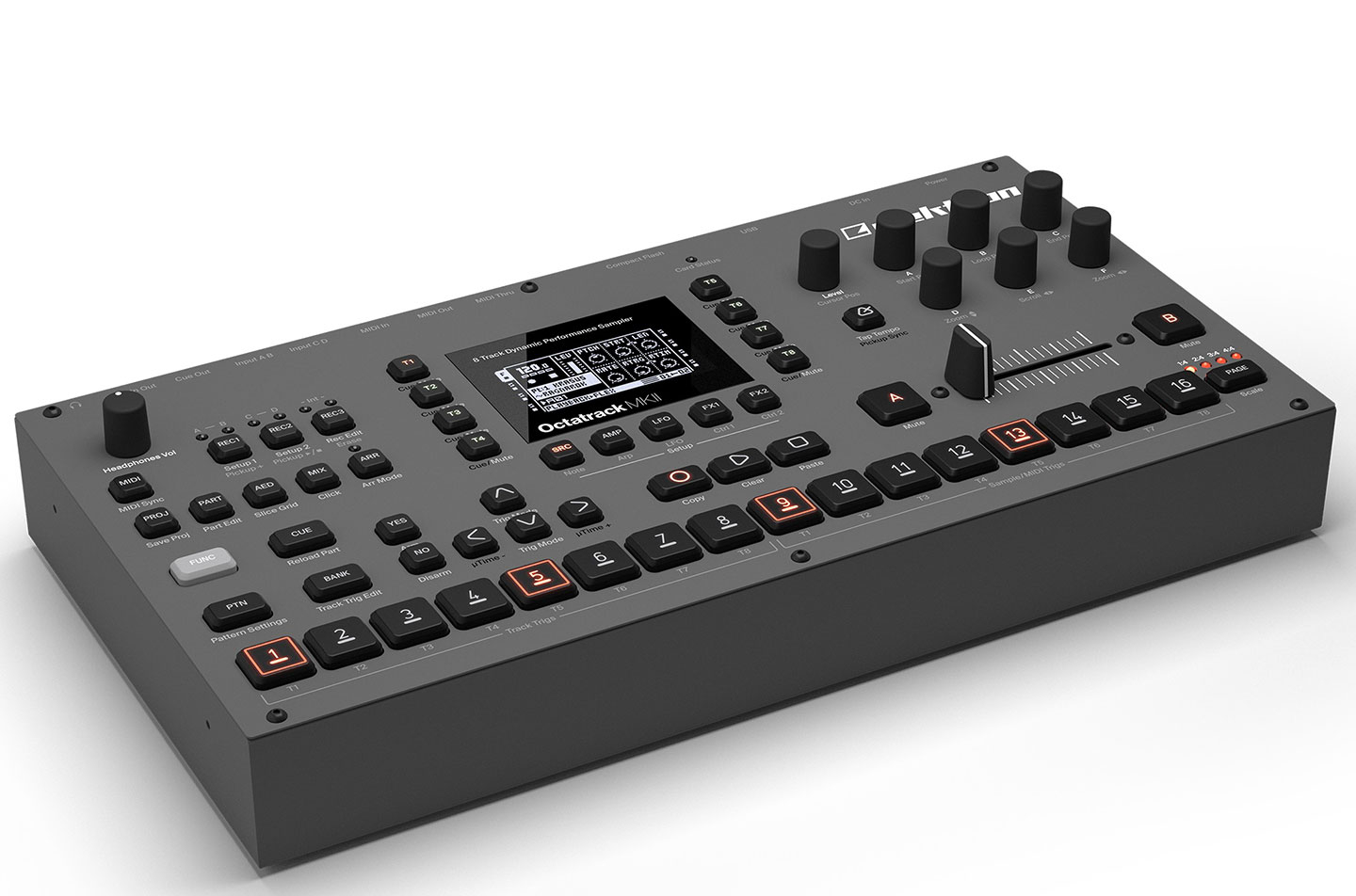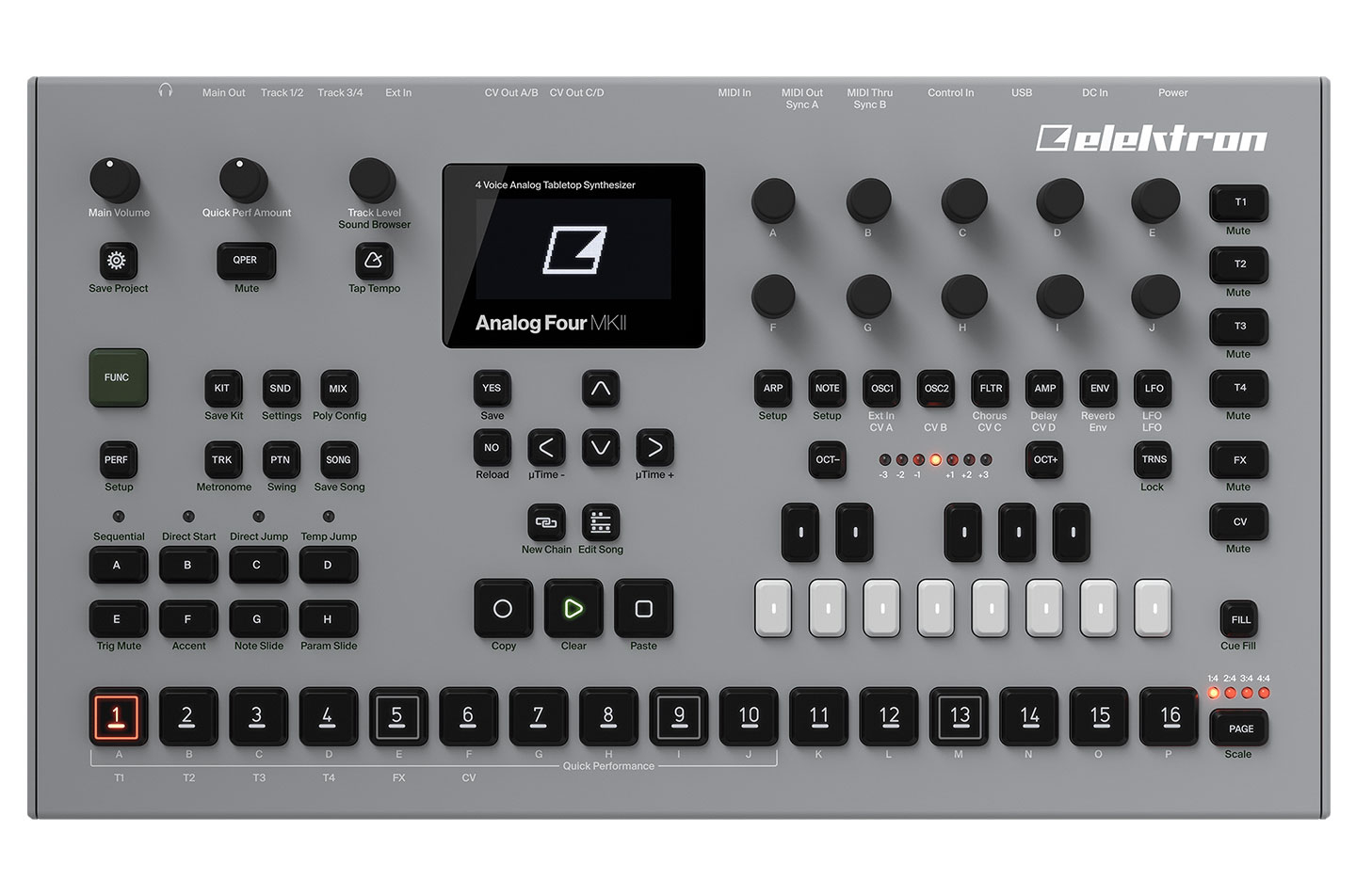Released
August / September 2017
- Two of dance music's most respected tools receive a long-awaited upgrade.
- Last summer, Elektron announced its first run of MKII devices since the dearly departed Machinedrum and Monomachine. As we've gone deep into both the original Octatrack and the Analog Keys, we'll focus here on what's new and improved in the MKII range.
Since its initial release six years ago, the Octatrack has established itself as a modern classic in the realm of hardware samplers. Renowned for its deep sound-mangling capabilities and notoriously steep learning curve, it's become ubiquitous. It's either the one piece of kit producers can't live without or the one they ditched after six months of confusion and frustration. With the MKII, Elektron seems eager to please both camps. They have proved their commitment to long-term support for the machine and made the user interface more accessible for those who may have been discouraged by the hours of manual study and muscle memory required to get a handle on the workflow.
Besides new dedicated buttons, the other primary improvement in the new Octatrack is the audio input circuitry. For such a high-end hardware sampler, it was a bit strange that the Octatrack's sampling inputs weren't up to par with the rest of the device's impressive specs. The four unbalanced audio inputs of the old model have been vastly improved here, with headroom boosted from a peak of +8 dBu to a whopping +17 dBu and input impedance at 21 kOhm (as opposed to the previous version's 9 kOhm). In practice, this means you can sample at much higher levels without clipping. For users accustomed to loading their samples via USB, this might not be reason to upgrade, but if you've long been frustrated by distorted, low-volume samples (or if you like to use the Octatrack's' internal mixer and effects for external audio), this makes a huge difference.
There have also been some small but essential updates on the firmware front. The most notable of these is trig conditions. This has become a flagship feature of Elektron boxes, and the Octatrack's otherwise impressive sequencer was beginning to lag without it. In essence, trig conditions create logic or probability rules for activating note triggers and parameter locks. Trig conditions are a quick way to turn a simple pattern into a constantly evolving sequence, changing in response both to itself and to any other track's patterns. The new OS runs on both the MKI and MKII models, so users who don't need the hardware upgrades can still benefit from this and other non-physical improvements.
With the Analog Four MKII, Elektron has added a new form factor to their previously consistent box design. The A4, as well as its sibling the Analog Rhythm MKII, have grown significantly in size. This might be a deterrent for producers who rely on Elektron boxes as backpack-friendly but full-powered music machines, but the added heft is worth it for the addition of individual track outputs. The enlarged panel also makes room for a new, more spacious user interface. Much has been made of Elektron's preference for hiding crucial functions and menus behind multi-button combinations, and the MKII somewhat remedies this problem by including more dedicated buttons. It's certainly nice to have new shortcuts, but many of the new buttons still have secondary functions (some of which are labeled in hard-to-read white text). Perhaps the best part of the new design is the larger screen, which is as crisp and snappy as promised. The MKI's minuscule display made Overbridge (or an external MIDI programmer) all but indispensable for deep programming without serious eyestrain, and the new screen with brighter, clearer graphics makes patch editing easier and faster. The on-board mini keyboard is also somewhat more piano-shaped and less cramped. For heavy-duty sequencing, I imagine most users will still prefer an external keyboard, but for quick changes and testing out patches, it's great.
Beyond the much-improved UI and extra outputs, there's been a few changes under the hood, too. Elektron has reworked the VCF overdrive circuit to retain more low-frequency information without too much level drop. The filters sound as good as they ever did, and the improved overdrive functionality really makes them shine.
On both the Analog Four and Octatrack, the encoders have been upgraded to two decimal point resolution, and though they make less of a satisfying click when pressed, I imagine they're more durable than the old ones. Additionally, all the front-panel buttons are now backlit. This might not seem very impressive but it's immensely helpful in reducing eyestrain from hours staring at blinky LEDs. It also makes it a little easier not to get lost in a sequence.
The sequencer buttons have all been upgraded to the square style first spotted on the Digitakt. This feature, even more than the added functional buttons, is a welcome improvement. The old plastic circular sequencer buttons took plenty of wear and tended to become wobbly, and in some cases, stuck after years of use (this may have been more of an issue on the Octatrack, where sequence step buttons served at least three purposes beyond punching in patterns). Overall, the changes on the MKII versions of the Octatrack and Analog Four tend towards subtle improvements. The new devices are certainly a bit more accessible to new users, but the hardware improvements will probably be most appreciated by power users who are happy with the workflow but seek improved performance.
Ratings:
Cost: 3.8
Versatility: 4.7
Ease of use: 4.0
Sound: 4.8
 Beyond the much-improved UI and extra outputs, there's been a few changes under the hood, too. Elektron has reworked the VCF overdrive circuit to retain more low-frequency information without too much level drop. The filters sound as good as they ever did, and the improved overdrive functionality really makes them shine. On both the Analog Four and Octatrack, the encoders have been upgraded to two decimal point resolution, and though they make less of a satisfying click when pressed, I imagine they're more durable than the old ones. Additionally, all the front-panel buttons are now backlit. This might not seem very impressive but it's immensely helpful in reducing eyestrain from hours staring at blinky LEDs. It also makes it a little easier not to get lost in a sequence. The sequencer buttons have all been upgraded to the square style first spotted on the Digitakt. This feature, even more than the added functional buttons, is a welcome improvement. The old plastic circular sequencer buttons took plenty of wear and tended to become wobbly, and in some cases, stuck after years of use (this may have been more of an issue on the Octatrack, where sequence step buttons served at least three purposes beyond punching in patterns). Overall, the changes on the MKII versions of the Octatrack and Analog Four tend towards subtle improvements. The new devices are certainly a bit more accessible to new users, but the hardware improvements will probably be most appreciated by power users who are happy with the workflow but seek improved performance. Ratings: Cost: 3.8 Versatility: 4.7 Ease of use: 4.0 Sound: 4.8
Beyond the much-improved UI and extra outputs, there's been a few changes under the hood, too. Elektron has reworked the VCF overdrive circuit to retain more low-frequency information without too much level drop. The filters sound as good as they ever did, and the improved overdrive functionality really makes them shine. On both the Analog Four and Octatrack, the encoders have been upgraded to two decimal point resolution, and though they make less of a satisfying click when pressed, I imagine they're more durable than the old ones. Additionally, all the front-panel buttons are now backlit. This might not seem very impressive but it's immensely helpful in reducing eyestrain from hours staring at blinky LEDs. It also makes it a little easier not to get lost in a sequence. The sequencer buttons have all been upgraded to the square style first spotted on the Digitakt. This feature, even more than the added functional buttons, is a welcome improvement. The old plastic circular sequencer buttons took plenty of wear and tended to become wobbly, and in some cases, stuck after years of use (this may have been more of an issue on the Octatrack, where sequence step buttons served at least three purposes beyond punching in patterns). Overall, the changes on the MKII versions of the Octatrack and Analog Four tend towards subtle improvements. The new devices are certainly a bit more accessible to new users, but the hardware improvements will probably be most appreciated by power users who are happy with the workflow but seek improved performance. Ratings: Cost: 3.8 Versatility: 4.7 Ease of use: 4.0 Sound: 4.8